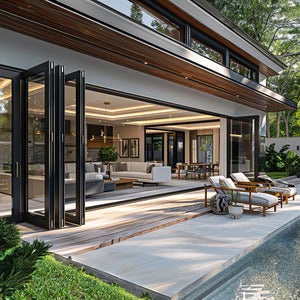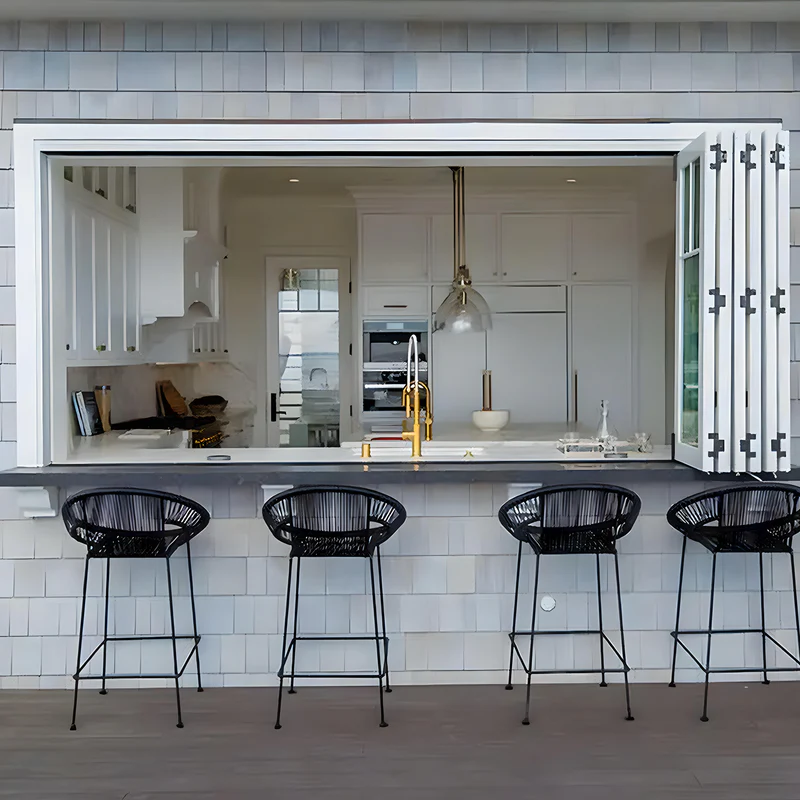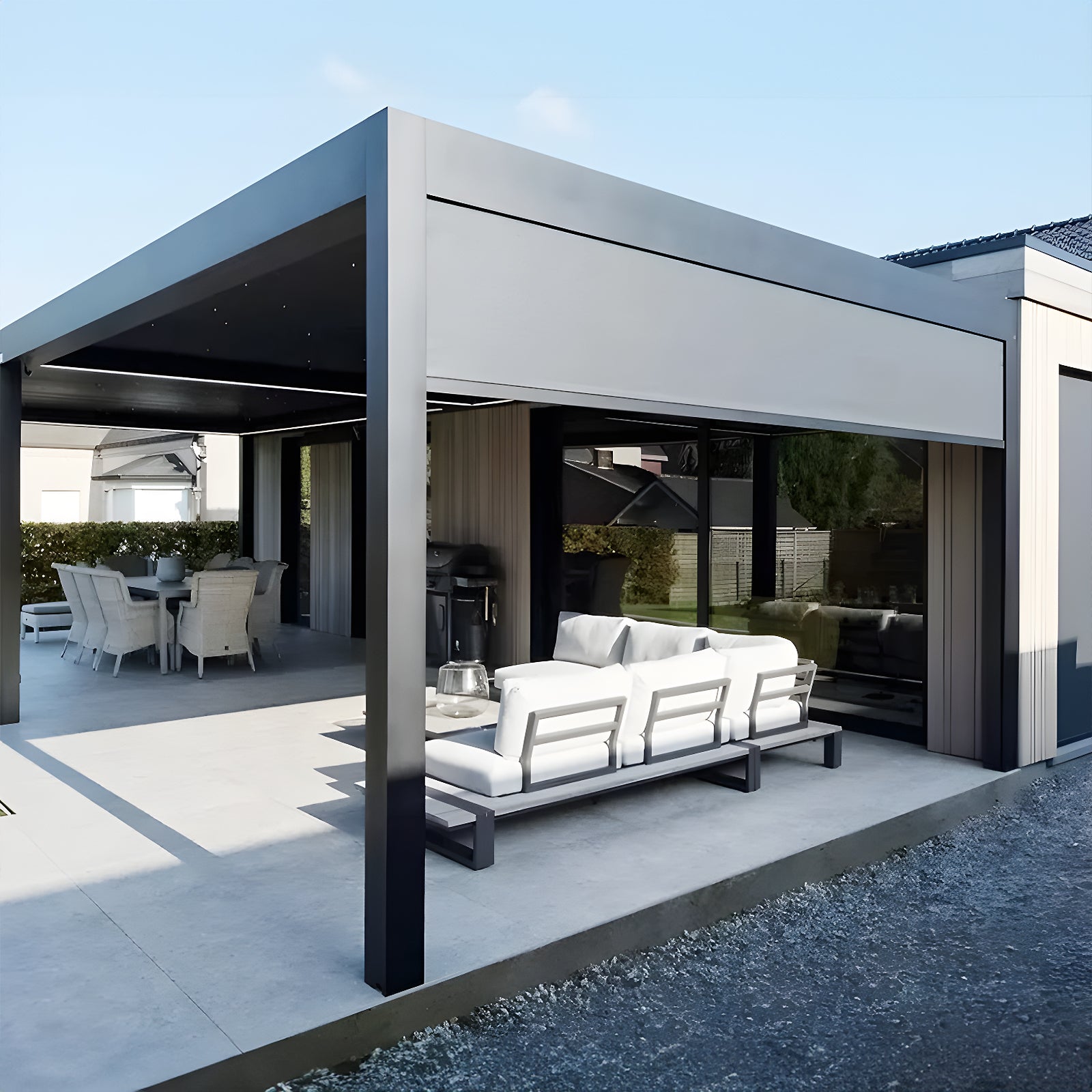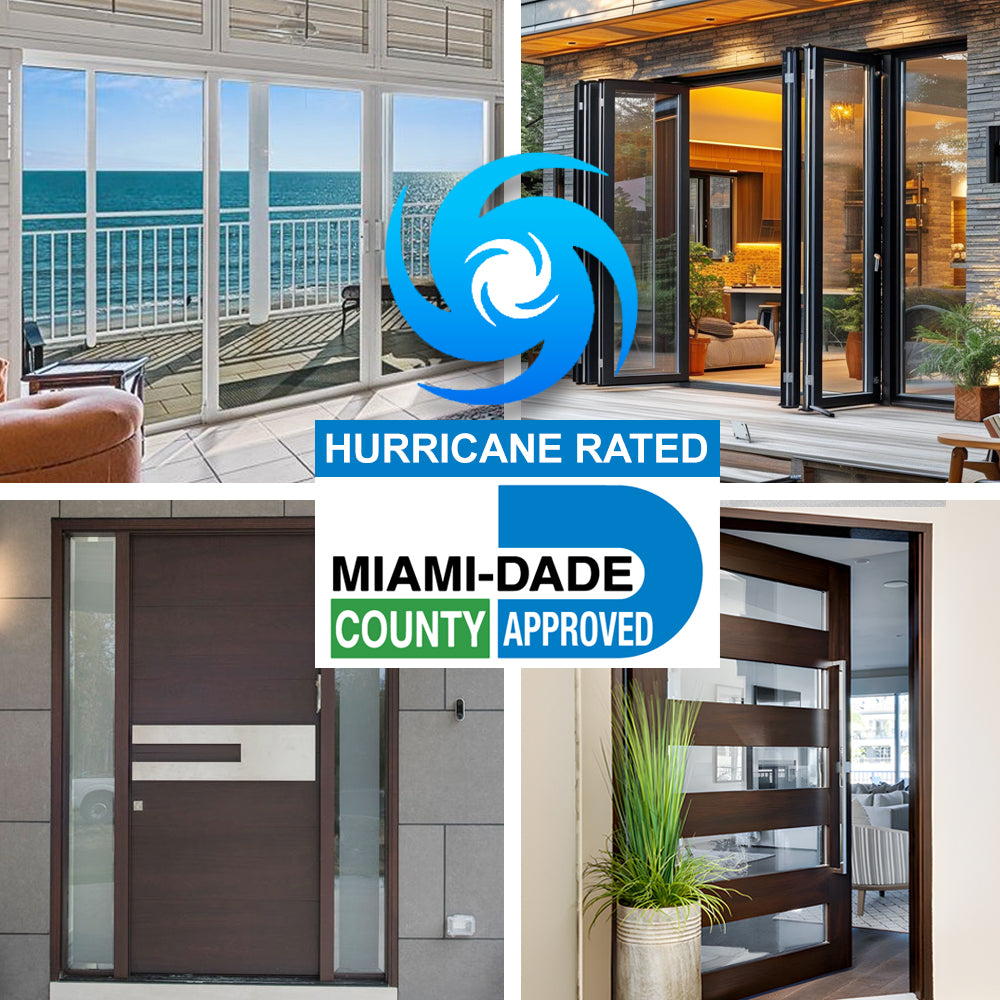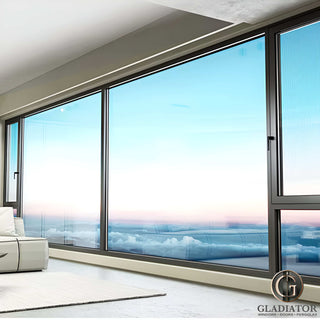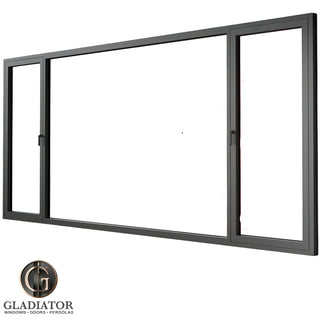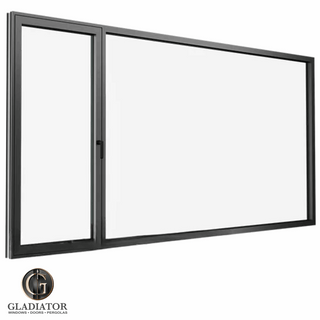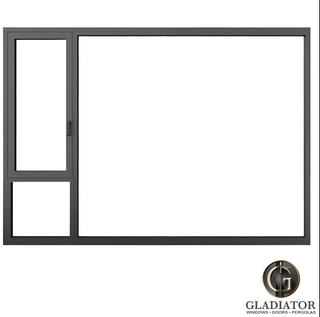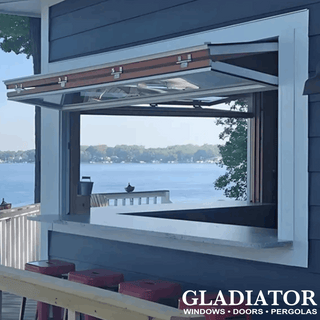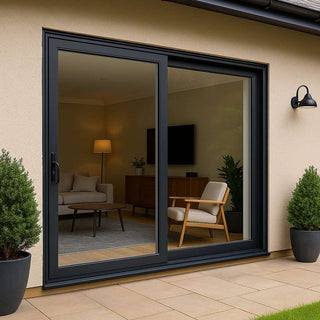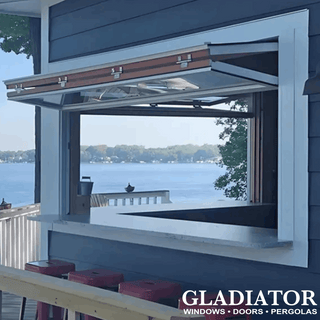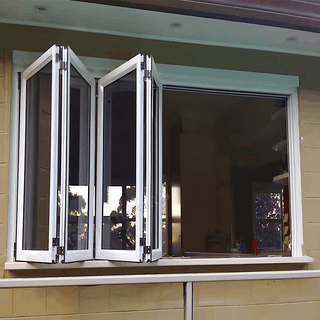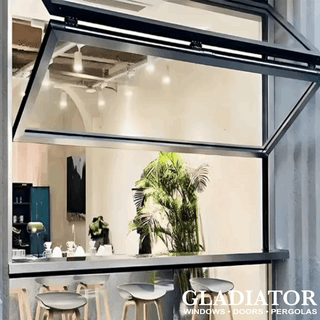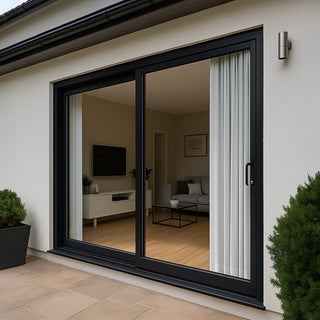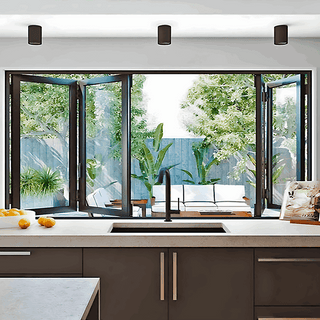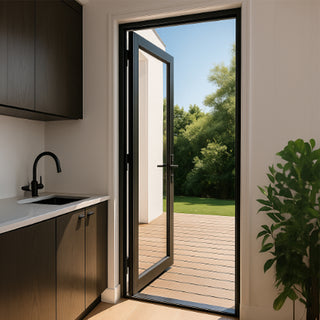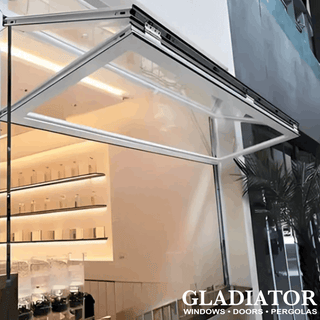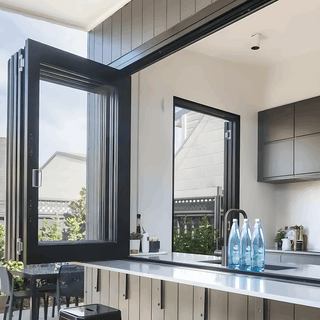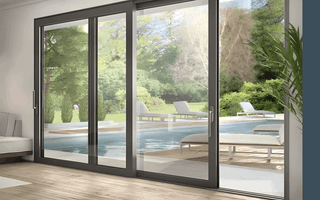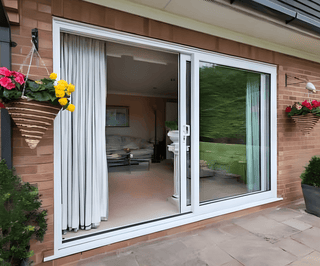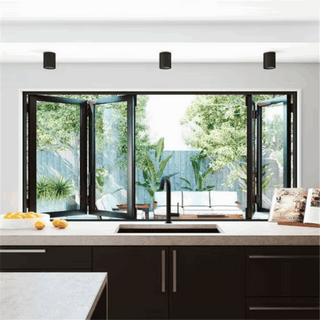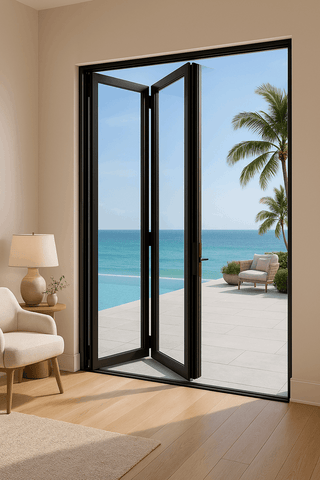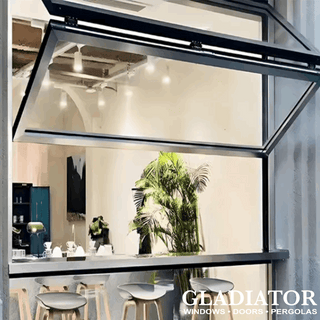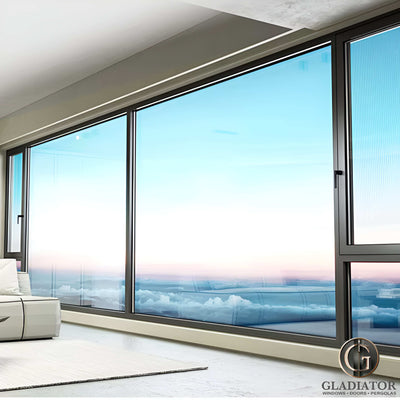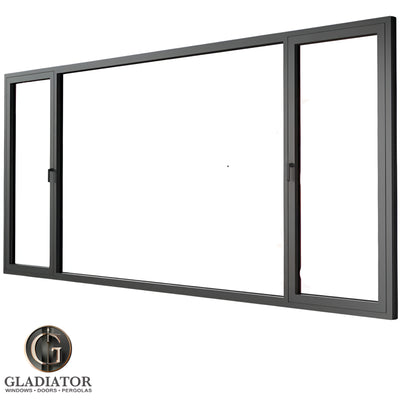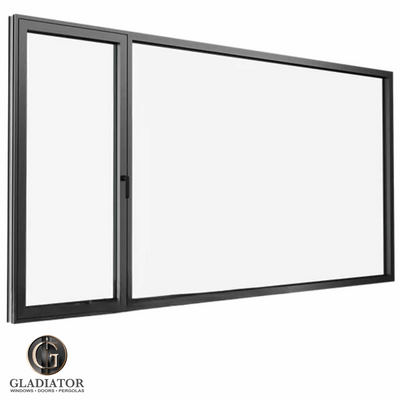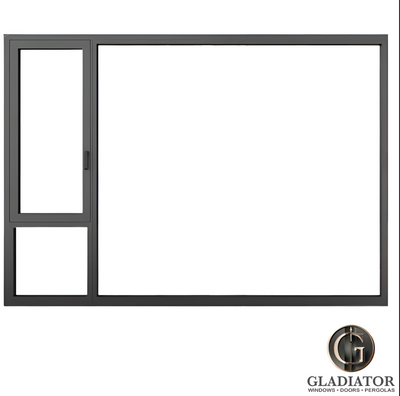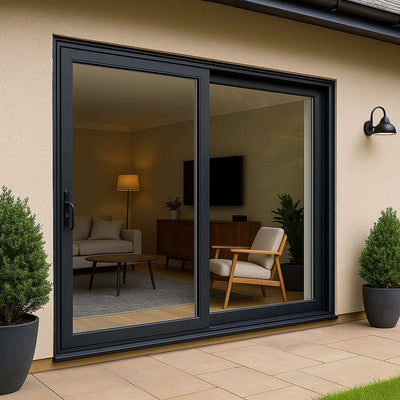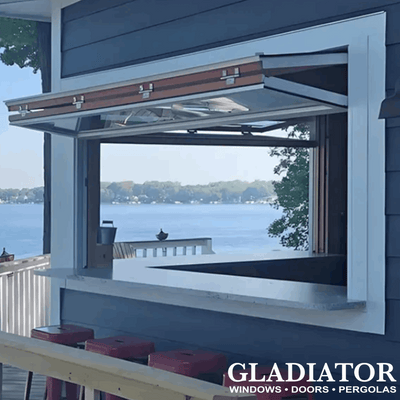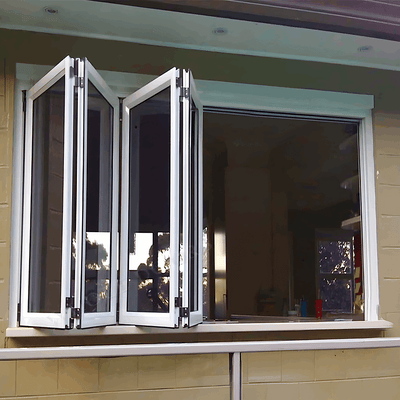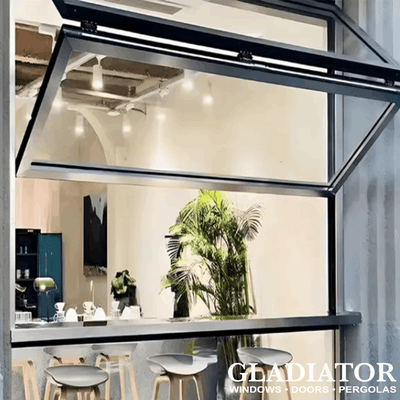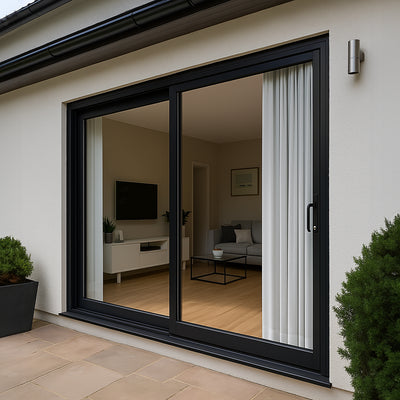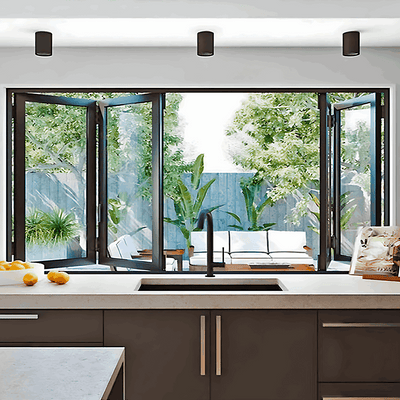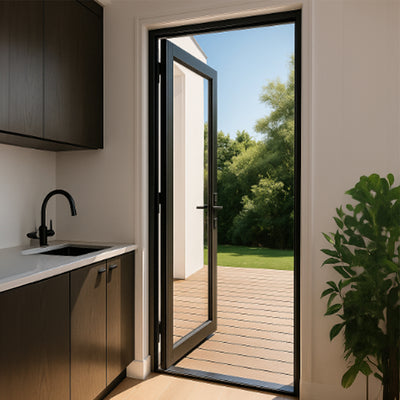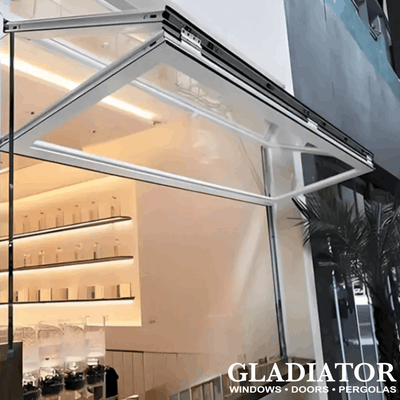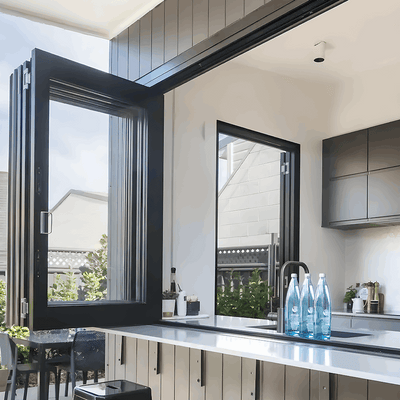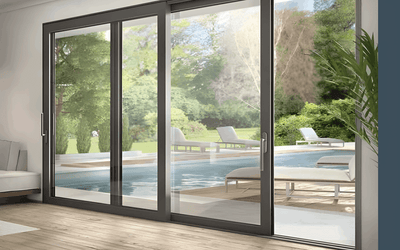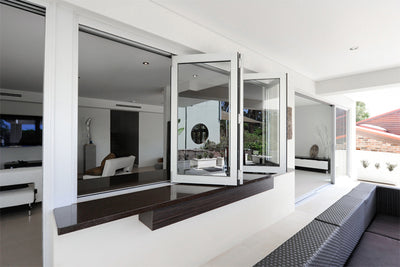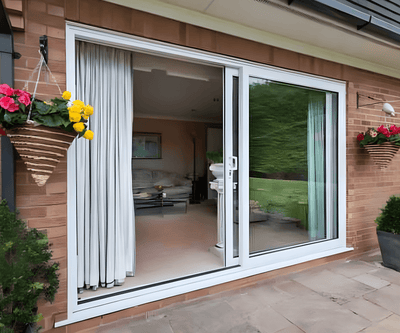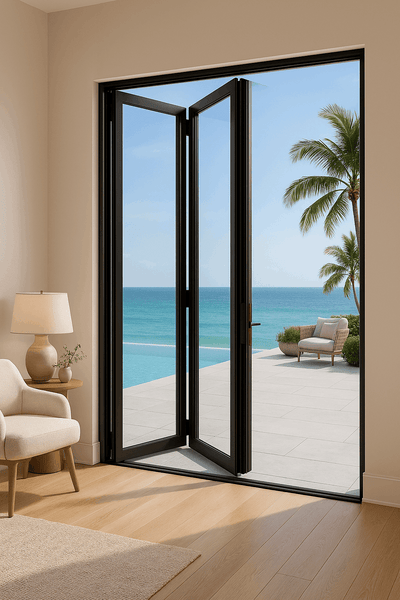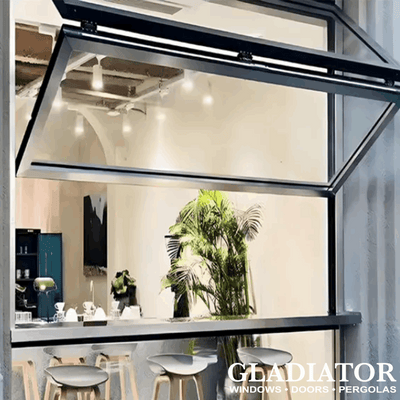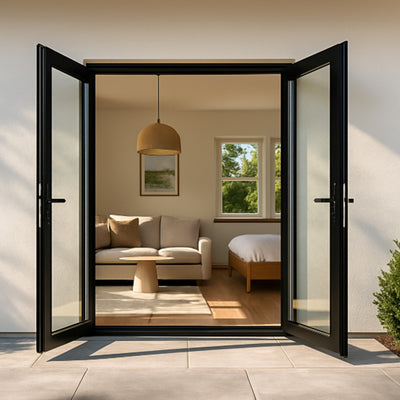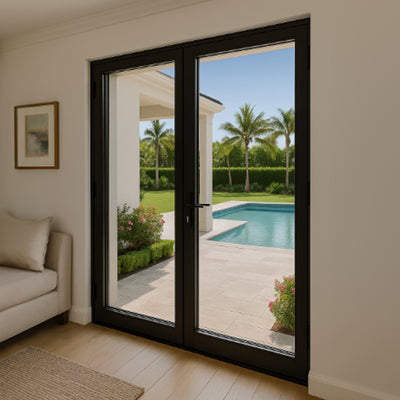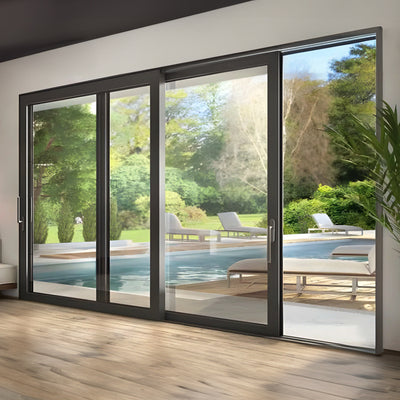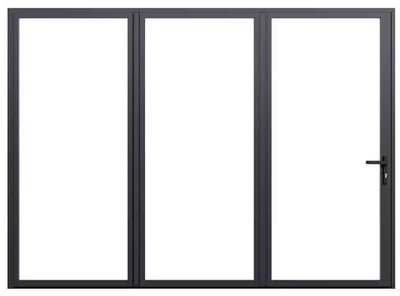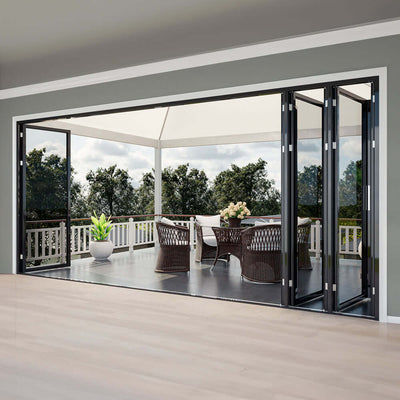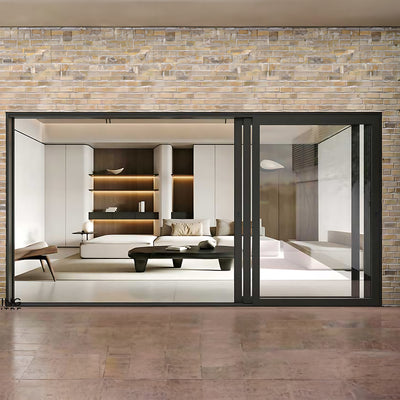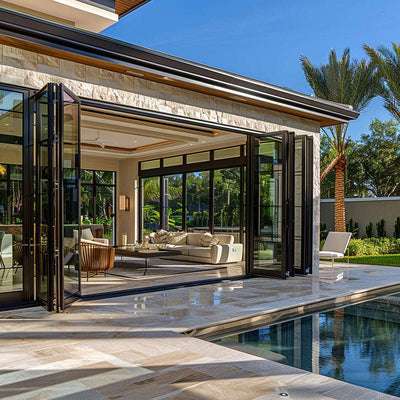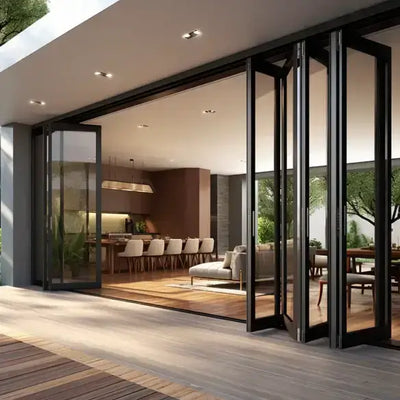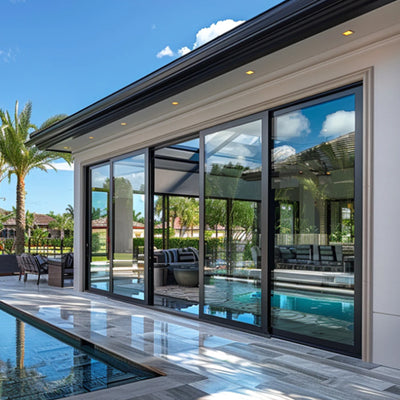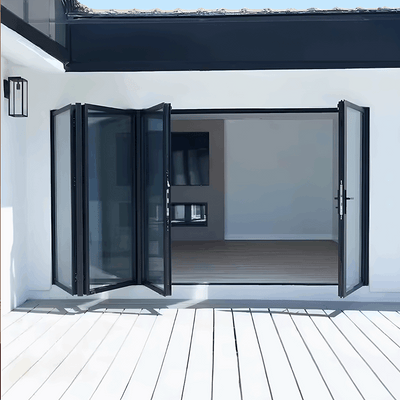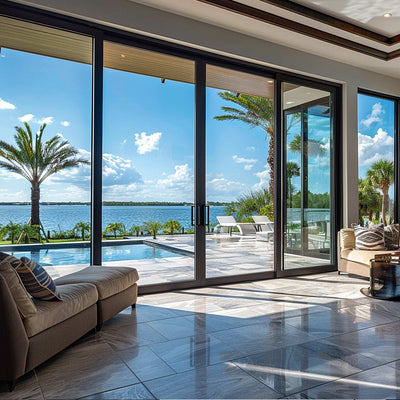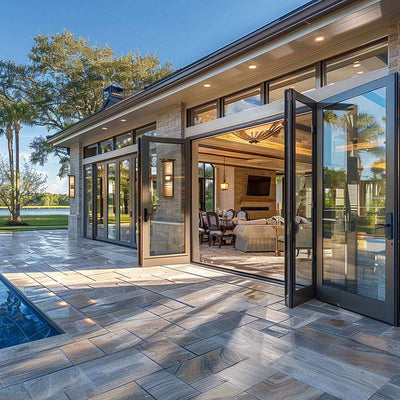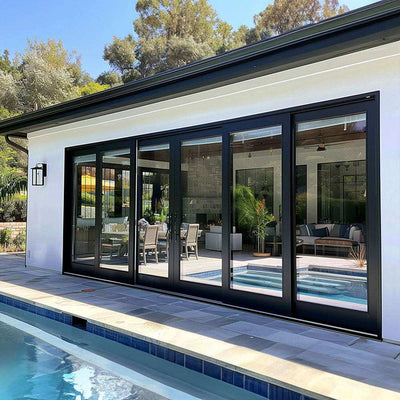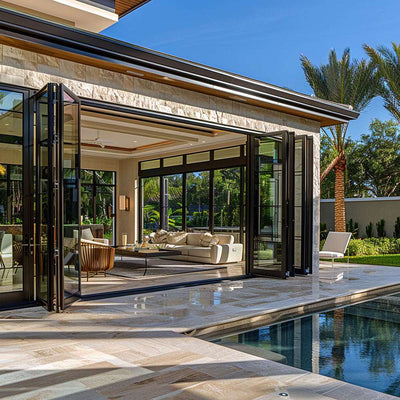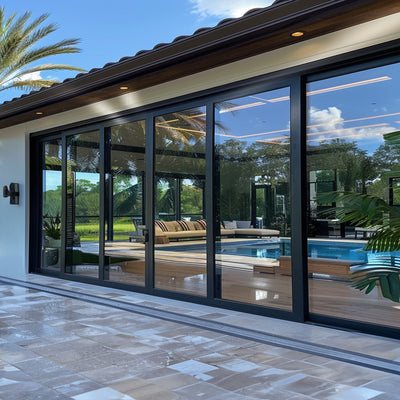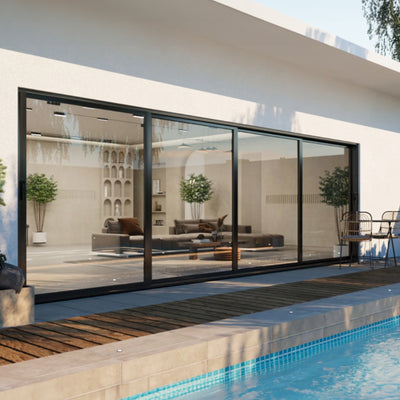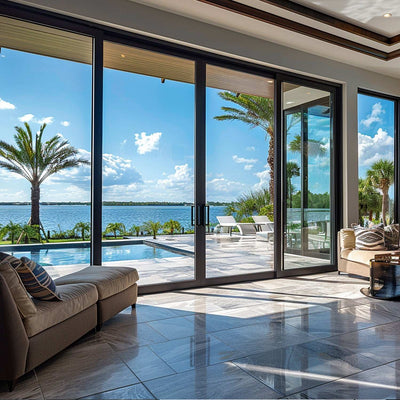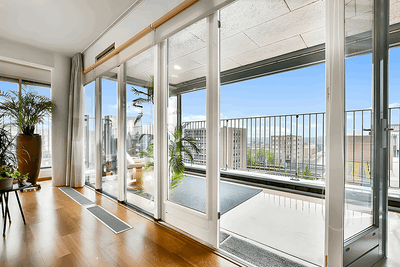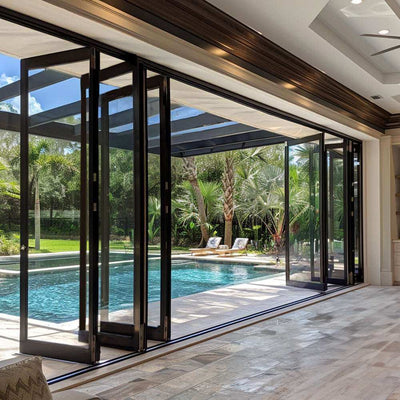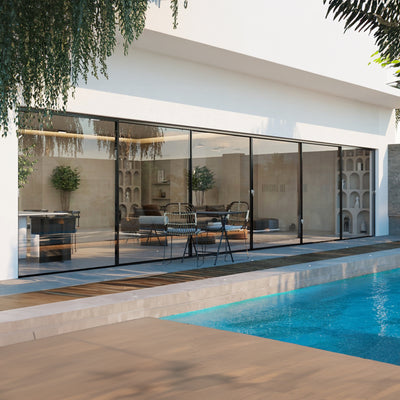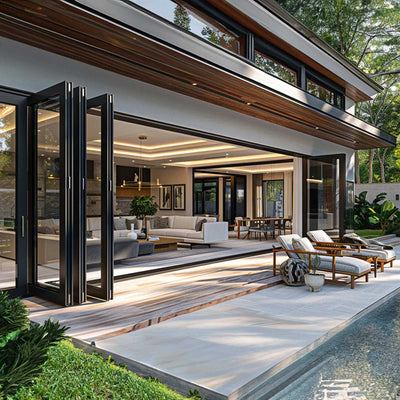Slide Into Style: Reimagine Your Space
Sliding doors: they're not just for closets anymore. Once a purely functional element, the sliding door has become a versatile design tool. It can redefine space, enhance natural light, and add a touch of elegance. From sleek, minimalist designs to rustic barn door styles, the variety of options is impressive. Understanding the nuances of each design, their history, and their impact on a space is key to making informed choices that elevate both form and function.
The concept of sliding doors has existed for centuries. Early examples can be found in Japanese architecture, where shoji screens created flexible, light-filled living spaces. This focus on spatial efficiency and connection with nature continues to influence modern designs. A truly effective sliding door seamlessly integrates into the overall architectural vision. It maximizes space while also serving as a striking visual element.
Modern innovations have expanded the possibilities even further. Motorized operation and advanced track systems offer unprecedented control and flexibility. Imagine effortlessly gliding a large glass door open to merge your indoor living space with a patio, all with the touch of a button. This level of control enhances the functionality and appeal of sliding doors in contemporary design.
Exploring Design Options
In this guide, we’ll explore various sliding door designs, examining their unique characteristics, benefits, and ideal applications. We'll look at:
- Bypass doors: A classic choice for closets and smaller spaces, bypass doors offer efficient space saving.
- Pocket doors: These doors disappear into the wall, maximizing floor space and creating a clean, uninterrupted look.
- Barn doors: Adding a touch of rustic charm, barn doors have become a popular choice for interior design.
- Glass sliding doors: These doors blur the lines between indoors and outdoors, maximizing natural light and creating a sense of openness.
Whether you're a homeowner renovating, a builder seeking innovative solutions, or a commercial property owner looking to optimize space, this exploration of sliding door designs will provide valuable insights. Discover how the right sliding door can transform your space from ordinary to extraordinary. From creating a flexible living area to adding a touch of unique style, sliding doors offer a wealth of design possibilities.
1. Minimalist Glass Sliding Doors
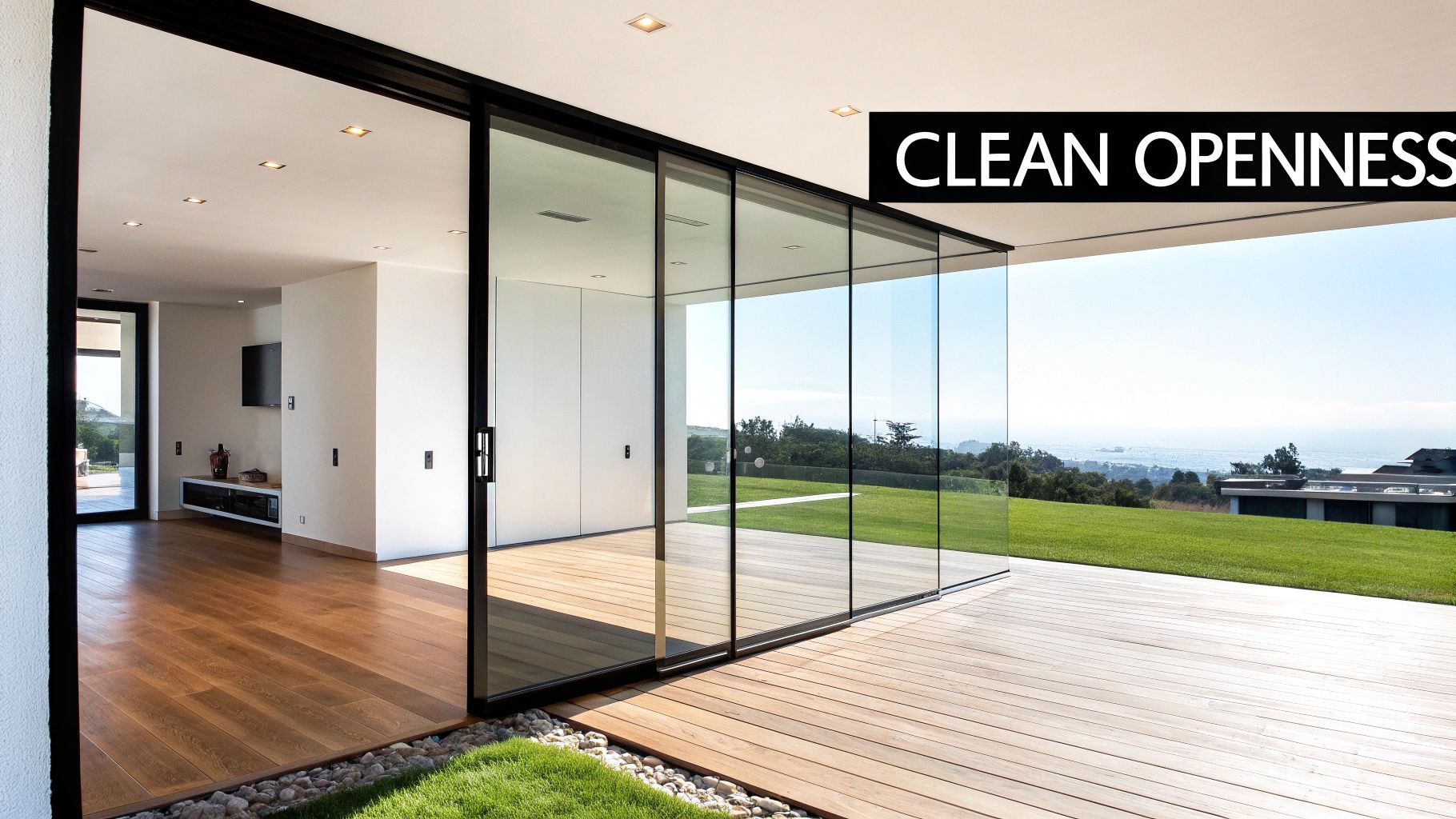
Minimalist glass sliding doors offer a sophisticated approach to home design. They prioritize clean lines, expansive glass panels, and minimal framing. This creates a sense of simplicity and seamless visual flow, maximizing natural light and openness. The sleek, often concealed hardware helps blur the lines between indoor and outdoor spaces.
These doors boast key features that contribute to their minimalist aesthetic. Floor-to-ceiling glass panels maximize views and natural light. Minimal, often concealed, track systems maintain a sleek, uninterrupted look. Frameless or thin-frame designs emphasize the beauty of the glass itself. Hidden hardware further enhances the minimalist appeal, ensuring smooth, silent operation.
Benefits of Minimalist Glass Sliding Doors
Incorporating minimalist glass sliding doors offers numerous benefits:
- Dramatically increased natural light: Creates the illusion of a larger, more airy space, which is particularly beneficial in smaller homes or apartments.
- Seamless indoor-outdoor connection: Extends living spaces onto patios, balconies, or gardens, creating a harmonious flow.
- Preserved views: Their low visual impact makes them ideal for homes with scenic surroundings.
- Seamless integration: This design style complements contemporary and modern architecture.
For more door options, check out our article about Gladiator Window & Door Collections Sitemap.
Considerations and Drawbacks
While the benefits are substantial, it's crucial to consider the potential drawbacks:
- Privacy: Can be a concern unless treated or tinted glass is used.
- Cost: Minimalist glass sliding doors often carry a higher price tag than traditional options.
- Maintenance: Maintaining the pristine glass requires regular cleaning.
- Energy Efficiency: They can be less energy-efficient than solid doors, though advancements like low-E coatings can help.
- Structural Support: Due to the weight of large glass panels, sturdy supporting structures are essential for safe installation.
Influential Companies and Design Philosophy
The popularity of minimalist glass sliding doors is largely due to innovative companies like Sky-Frame, Vitrocsa, Klein, and Fleetwood. Their advanced systems have pushed the boundaries of architectural glass design. These systems are featured in high-end projects worldwide. From luxury apartments using Sky-Frame's slim profiles to the iconic Barcelona Pavilion renovation showcasing Vitrocsa’s systems, these doors have made their mark. Even Google's headquarters utilize Klein’s frameless glass partitions. Fleetwood's floor-to-ceiling glass walls are a staple in modern California homes. The legacy of architect Ludwig Mies van der Rohe, a pioneer of indoor-outdoor continuity, also contributed significantly to the popularization of this design.
Practical Tips for Installation
For those considering minimalist glass sliding doors, here are a few practical tips:
- Energy Efficiency: Opt for low-E coatings to enhance energy performance.
- Sound Insulation: Double-glazed panels improve sound insulation.
- Safety: Automatic soft-close mechanisms add safety, especially for families with children.
- Seamless Transition: Recessed floor tracks create a truly seamless transition between spaces.
- Ease of Operation: Automated systems can make operating large or heavy doors easier.
These doors offer a compelling blend of functionality and aesthetic appeal. Their unique ability to connect living spaces with the surrounding environment makes them a popular choice for modern homeowners and architects.
2. Pocket Sliding Doors
Pocket sliding doors offer a sleek and innovative solution for maximizing space. They create a seamless flow between rooms, unlike traditional swing doors. Pocket doors disappear into a wall cavity when opened. This eliminates the need for a door swing area, providing an unobstructed opening.
This feature makes them attractive for smaller homes, apartments, or any area where space is limited. When closed, they function and appear much like standard doors, maintaining privacy and visual separation between rooms.
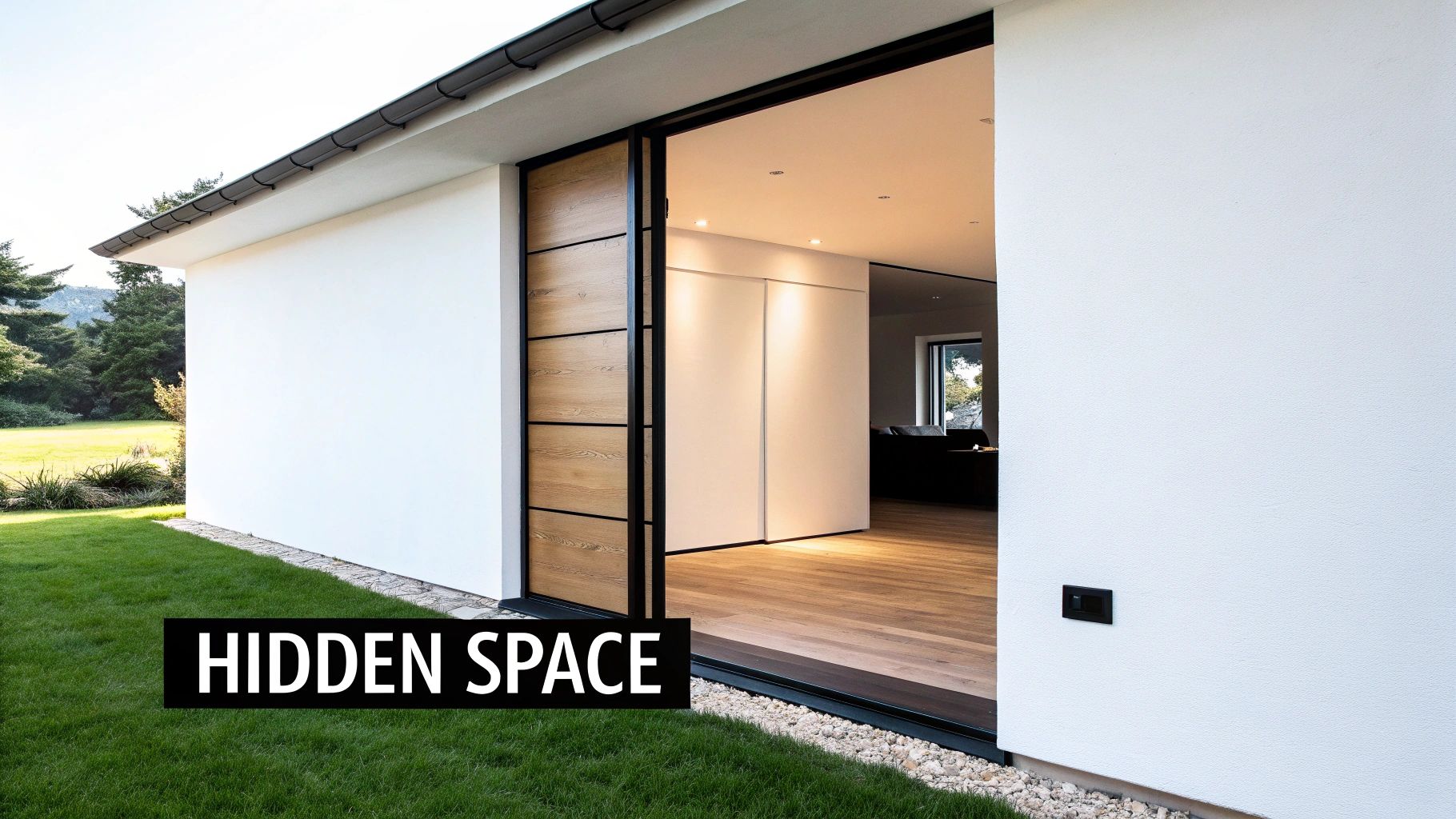
Key Features and Benefits
The key feature is the specialized pocket built into the wall framing. This cavity houses the door when open, along with a hidden track system. This system allows for smooth and silent operation. Pocket doors can be configured as single or double doors, opening from one or both sides of the wall.
They are available in various materials and styles to complement any interior design. From classic wood panel doors to modern frosted glass options, pocket doors offer a versatile solution for dividing spaces. The benefits of installing pocket doors are numerous:
- Significant floor space savings
- Clean, unobstructed openings
- Flexible space division options
These advantages make them ideal for maximizing usable square footage in tight spaces. They also work well for creating open-concept living areas. Luxury apartments often utilize Johnson Hardware's 1500 Series pocket door systems for a sense of spaciousness. Boutique hotels use systems from Cavity Sliders USA for sleek transitions between rooms. Modern office spaces employ Eclisse pocket door systems. In healthcare facilities, CS For Doors solutions offer accessibility and privacy. For more product details, see Our guide on Window and Door Products.
Historical Context and Modern Applications
Architect Frank Lloyd Wright integrated this space-saving technique into his prairie homes. Today, leading manufacturers like Johnson Hardware, Cavity Sliders USA, Eclisse, and CS For Doors continue to refine pocket door hardware and systems.
Important Considerations
It's important to consider potential drawbacks. Installation requires specific wall construction or renovation. This makes them more complex and typically more expensive than surface-mounted sliding doors. The wall cavity limits space for electrical outlets or switches. Repairs can also be challenging.
Tips for Successful Installation
For successful implementation, ensure the wall cavity is at least 2 inches wider than the door. Invest in quality hardware for smooth, long-term operation. Consider sound-insulating the pocket cavity for enhanced privacy. Install blocking within the wall framing for mounting fixtures on adjacent walls. Careful planning of electrical and plumbing is essential to avoid conflicts with the door pocket.
3. Barn Door Style Sliders
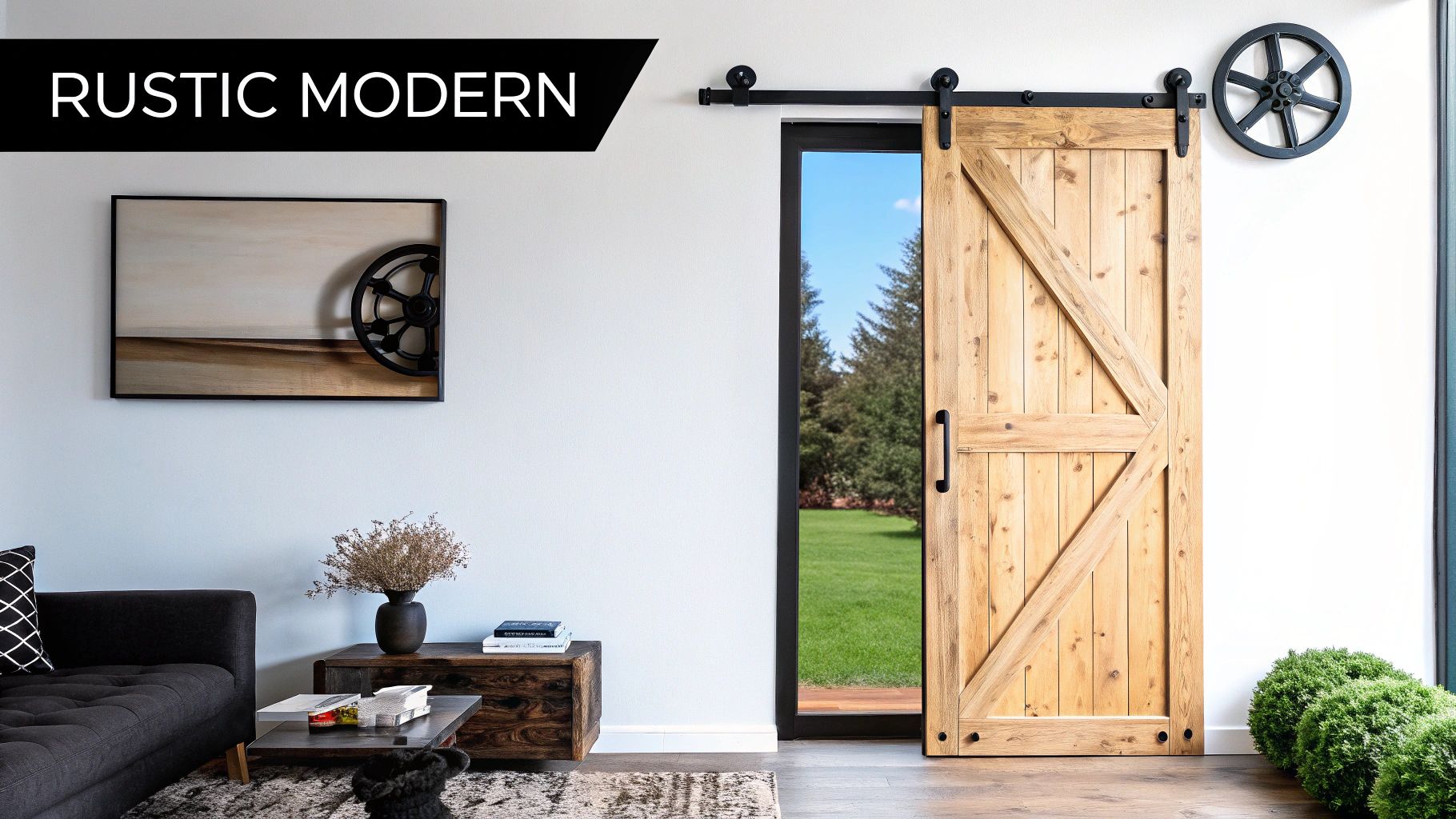
Barn door style sliders bring a unique combination of practicality and rustic charm to interior design. Unlike traditional sliding doors that vanish into the wall, barn doors hang from a visible track system, adding to the overall aesthetic. This exposed hardware, often with decorative rollers and track designs, creates visual interest in any room. While their popularity surged with the farmhouse chic trend promoted by figures like Joanna Gaines of 'Fixer Upper,' their adaptability has made them suitable for various styles, from rustic to modern and minimalist.
This sliding door style is characterized by its exposed overhead track. The door, commonly made of solid wood, metal, or even glass, hangs on this track with rollers and slides along the wall. This design makes them a space-saving alternative to traditional swing doors, especially in smaller areas where a swinging door would obstruct walkways or furniture. They can be customized with a wide range of door materials and finishes.
Features
- Exposed overhead track system
- Decorative rollers and hardware
- Typically made from solid wood, metal, or glass
- Hangs in front of the wall
- Variety of door styles, from rustic to contemporary
Pros
- Visual Appeal: The exposed hardware and sliding mechanism create a striking focal point.
- Easy Installation: Barn door systems are generally easy to install, often without significant wall modifications, making them ideal for retrofits.
- Space-Saving Design: They conserve floor space compared to traditional swing doors.
- Design Versatility: Adaptable to different door materials, finishes, and styles.
- Retrofit Friendly: Easily installed in existing doorways.
Cons
- Limited Soundproofing and Privacy: The gap between the door and the wall reduces soundproofing and privacy compared to standard doors.
- Visibility When Open: The door remains visible along the wall when open, a potential aesthetic drawback.
- Wall Space Requirement: Adequate wall space is needed beside the opening for the door to slide open.
- Privacy Concerns: The gap between the door and wall may raise privacy issues in certain areas like bathrooms.
- Hardware Expense: High-quality hardware can be costly.
Real-World Examples
- Rustica Hardware: Known for custom barn door systems often seen in restaurants, adding an industrial chic vibe.
- Artisan Hardware: Offers high-end designs frequently found in luxury homes.
- Real Carriage Door Company: Specializes in barn door installations for luxury farmhouse renovations.
- Krownlab: Designs modern barn door systems for commercial applications.
Tips for Implementation
- Structural Integrity: Ensure the wall can support the door's weight, especially for heavier materials like solid wood.
- Soft-Close Mechanisms: Consider soft-close mechanisms to prevent slamming and provide smooth operation.
- Bottom Guide: A bottom guide stabilizes the door and prevents swinging.
- Rubber Bumpers: Install rubber bumpers to protect the wall from damage.
- Overlap: A 1-inch overlap on all sides of the opening enhances privacy.
Barn door sliders earn a spot on this list as a stylish and space-saving alternative to traditional doors. Their versatility, ease of installation, and unique visual appeal have made them a favorite among homeowners, contractors, and designers. Whether for a farmhouse renovation, a modern home, or a commercial space, barn doors offer a distinct and functional solution.
4. Japanese Shoji Sliding Doors
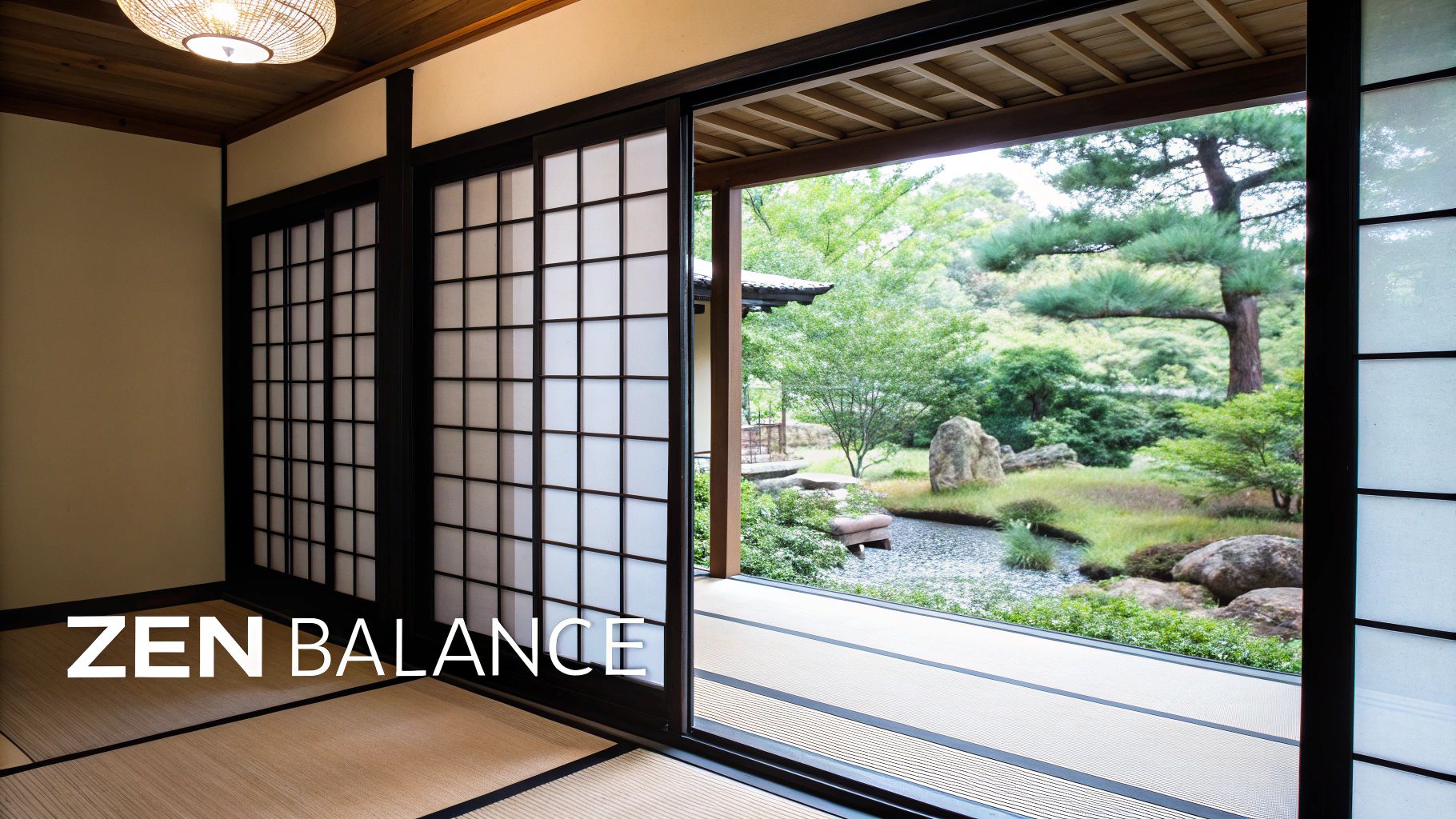
Japanese shoji sliding doors offer a beautiful blend of function and visual appeal, earning them a spot on our list of top sliding door designs. These doors, originating in traditional Japanese architecture, are known for their lightweight wood frames and translucent panels. This creates a peaceful and calming atmosphere. Their simple elegance makes them an appealing choice for homeowners, contractors, and builders working on both residential and commercial projects.
Shoji doors are built with a wooden lattice grid framework called kumiko. This framework supports the translucent panels. Traditionally, these panels were made of rice paper, diffusing a soft light. Modern versions often use more durable materials like acrylic or fiberglass. This improves their lifespan and simplifies maintenance while keeping the classic look. These doors slide smoothly and effortlessly on a top and bottom track system. Their modular panel design allows for flexible configurations to fit a variety of openings and spaces.
The Beauty of Shoji Doors
The real beauty of shoji doors lies in their ability to filter light beautifully while also offering privacy. They create a sense of tranquility and add a unique cultural touch to any room. Their lightweight design makes them easy to use. And their ability to divide a space while allowing light to flow through is truly remarkable.
Examples of their versatility can be seen in traditional settings like Kyoto's Katsura Imperial Villa, as well as in modern applications. Companies like Raydoor have incorporated them into meditation spaces, and Cherry Tree Design features them in residential projects. Even retailers like Oriental Furniture offer adaptable systems for contemporary apartments.
While traditional materials can be delicate and require upkeep, modern materials offer greater durability. Our sitemap provides further information on door maintenance and options. It’s worth noting that shoji doors provide limited sound insulation and less security than solid doors. Authentic shoji doors, made with traditional materials and techniques, can also be expensive.
Practical Tips for Using Shoji Doors
For those interested in incorporating shoji doors, here are a few helpful tips:
- Choose synthetic papers or acrylics for durability, especially in humid climates.
- Consider insulated versions for exterior use.
- Opt for high-quality wood such as basswood or cedar for the frame.
- Install them in areas where soft, diffused light is desired.
- Pair them with tatami flooring for a truly authentic Japanese aesthetic.
The enduring popularity of shoji doors is rooted in traditional Japanese architecture. Contemporary adaptations by architects like Tadao Ando, along with specialized companies like Raydoor and Cherry Tree Design, have further cemented their appeal. Their timeless elegance and practical design continue to attract those looking to create beautiful and peaceful spaces.
5. Multi-Panel Folding Sliding Doors
Multi-panel folding sliding doors, also known as bifold or accordion doors, offer a unique way to open up a space. These systems use multiple panels connected by hinges, allowing them to fold and stack neatly when opened. This design is perfect for creating a wide, open feel without sacrificing floor space. Their adaptability makes them a popular choice for connecting indoor and outdoor spaces or creating flexible partitions in homes and businesses.
These doors operate on a top and bottom track system, ensuring smooth movement. They come in various configurations, accommodating both odd and even panel numbers, with options for inward or outward stacking. You can even choose single-side or double-side stacking to fit your space. For exterior use, weather-sealed options provide protection from the elements.
Features and Benefits
-
Maximized Openings: Create expansive, unobstructed openings, blurring the lines between indoors and out.
-
Flexible Space Management: Effortlessly transform spaces, opening or dividing rooms as needed.
-
Indoor-Outdoor Living: Open entire walls to seamlessly integrate indoor and outdoor living areas.
-
Space-Saving Design: Occupy less space than traditional swing doors, maximizing usable floor area.
-
Material Variety: Choose from various materials, including glass, wood, and aluminum, to match your style.
Pros and Cons
Here’s a quick look at the advantages and disadvantages:
| Pros | Cons |
|---|---|
| Creates wide, unobstructed openings | More complex operation than single sliders |
| Provides flexible space management | Requires precise installation |
| Ideal for indoor-outdoor living | Track systems can be tripping hazards |
| Saves space compared to swing doors | More maintenance due to multiple parts |
| Available in various materials | Higher cost for quality systems |
Real-World Examples
High-end manufacturers like NanaWall, LaCantina Doors, and Centor have showcased the potential of these systems. NanaWall is often seen in luxury beachfront properties. LaCantina Doors are popular in high-end restaurants with patios. Centor’s integrated systems are frequently found in modern homes. Pella's Architect Series also offers high-quality options. The influence of architects like Richard Neutra, a champion of indoor-outdoor living, is evident in these systems’ continued popularity.
Tips for Implementation
-
Energy Efficiency: Choose thermally broken frames to reduce heat transfer.
-
Seamless Transitions: Consider flush sill options for a smooth transition between inside and out.
-
Security: Install multi-point locking systems.
-
Durability: Use quality hardware rated for the door weight.
-
Structural Support: Ensure adequate structural support above the opening.
Why Multi-Panel Folding Doors Deserve a Place on This List
Multi-panel folding doors combine functionality and style, offering a compelling alternative to traditional doors. Their ability to maximize openings, create flexible spaces, and enhance indoor-outdoor living makes them a valuable addition to any project. They're particularly well-suited for creating a dramatic architectural statement while maximizing space.
6. Smart/Motorized Sliding Doors
Smart/motorized sliding doors offer a significant upgrade from traditional sliding doors, providing hands-free convenience and seamless integration with modern smart home systems. These doors use electric motors for automated operation, eliminating the need for manual opening and closing. This is a huge benefit for people with mobility limitations, improving accessibility at home or in commercial spaces.
The key feature of these doors is their smart connectivity, often through Wi-Fi, Bluetooth, or Z-Wave. This allows control through various means including remote controls, smartphone apps, motion sensors, and even voice commands. Advanced systems can integrate with home automation hubs like Samsung SmartThings or Apple HomeKit, allowing for seamless operation with other smart devices. Imagine programming the doors to automatically close when your security system is armed, or to open as you approach the entrance with groceries. Programmable opening and closing speeds provide further customization, allowing for adjustments based on individual preferences or specific situations.
Security and Convenience Combined
Beyond convenience, smart sliding doors enhance security. Integration with security systems allows for automated locking and unlocking. Some models even have advanced obstacle detection sensors to prevent accidents. This blend of convenience and security makes them an attractive option for modern homes and commercial buildings. For a broader look at door and window choices, you might be interested in: Our Product Sitemap.
Industry leaders like Dormakaba, Assa Abloy (with their Besam line), Stanley Access Technologies, and Record USA have been instrumental in developing and implementing these systems, showcasing their effectiveness in various settings. From automatic sliding systems in commercial buildings and healthcare facilities to high-traffic areas like airports, these companies demonstrate the versatility and reliability of motorized door solutions.
Weighing the Costs and Benefits
While the initial cost and installation can be more complex and expensive compared to traditional sliding doors, the long-term benefits are often worth the investment. It's important, though, to be aware of potential downsides. These doors require a power supply, though many models include battery backups for continued operation during power outages. Regular maintenance by a professional might be necessary, and the potential for technological obsolescence should be considered. More complex systems have more components, increasing the potential for malfunctions.
Pros:
- Convenient hands-free operation
- Increased accessibility
- Programmable settings
- Home automation integration
- Enhanced security options
Cons:
- Power supply dependency (mitigated by battery backups)
- Higher initial cost and installation complexity
- Potential need for professional maintenance
- Technological obsolescence risk
- More complex systems with more potential points of failure
Tips for Implementation:
- Battery Backup: Ensure your system has a battery backup for uninterrupted service during power outages.
- Variable Speeds: Program different opening/closing speeds based on the user or the time of day. Slower door speeds might be safer for children.
- Safety Sensors: Ensure safety sensors are installed correctly and tested regularly to avoid accidents.
- Quiet Operation: Consider motors with quiet operation for bedrooms and living areas.
- Manual Override: Plan for easily accessible manual override options in case of a power failure or system malfunction.
Smart sliding doors are a glimpse into the future of door technology. They combine convenience, accessibility, and security in a single solution, offering a valuable upgrade for modern homes and commercial spaces. By understanding the features, benefits, and potential drawbacks, you can make a well-informed decision about whether smart sliding doors are the right choice for you.
7. Industrial-Style Metal Framed Sliding Doors
Industrial-style metal framed sliding doors offer a compelling blend of strength and transparency, adding architectural character to any space. Inspired by early 20th-century factory windows, these doors typically feature slim steel or aluminum frames surrounding glass panels. This creates a look that is both robust and refined. This style has seen a resurgence, appearing in urban lofts, renovated warehouses, and contemporary homes.
The slim metal framing, often made of steel or aluminum, is a defining characteristic of these doors. The frames come in various configurations, allowing for multiple glass panels and mimicking the mullion patterns of vintage factory windows. Exposed hardware with an industrial finish enhances the aesthetic, often complemented by floor-mounted or ceiling-hung tracking systems. This emphasis on visible hardware contributes to the doors' industrial character.
Origins and Inspiration
The popularity of these doors can be linked to companies like Crittal Windows, the original steel window manufacturer. Their designs, often called "Crittal-style" partitions, have become synonymous with the style, especially in SoHo loft renovations. Other manufacturers like Steel and Peach, Riviera Bronze, and Hope's Windows have further solidified the trend. Architects like Tom Kundig, known for incorporating industrial elements into residential designs, have also contributed to the style's appeal.
Pros and Cons of Industrial-Style Doors
Here's a breakdown of the advantages and disadvantages of these distinctive doors:
| Pros | Cons |
|---|---|
| Creates an architectural focal point | Metal frames conduct heat/cold without thermal breaks |
| Combines transparency with defined structure | Heavier than all-glass systems |
| Durable and long-lasting materials | Can be expensive due to custom manufacturing |
| Works with various interior styles | Limited soundproofing without specialized glass |
| Allows light flow with visual separation | May require professional installation |
Tips for Implementing Industrial-Style Doors
- Durable Finishes: Consider powder-coated finishes for enhanced durability and color options.
- Thermal Performance: For exterior use or in climates with temperature fluctuations, opt for thermally broken frames to improve energy efficiency.
- Glass Selection: Choose glass based on your privacy and insulation needs. Frosted or textured glass offers privacy, while double-paned or insulated glass enhances thermal performance.
- Smooth Operation: Invest in high-quality rollers for smooth operation, especially given the doors' weight.
- Architectural Harmony: Ensure the panel divisions complement your space's overall architectural style.
For more information on various window and door styles, you might be interested in: Our guide on window and door resources.
The versatility of industrial-style metal framed sliding doors makes them a valuable addition to any design project. Their blend of historical inspiration and modern functionality provides a unique option for creating a space with visual impact and character.
8. Curved Sliding Doors
Curved sliding doors offer a striking departure from conventional sliding door designs, blending functionality with a unique artistic flair. Instead of moving along a straight line, these doors glide along custom-engineered curved tracks, creating dynamic transitions between spaces. This adds a touch of architectural drama that standard linear sliding doors can't replicate. Thanks to advancements in glass bending and track system technologies, these once highly specialized doors are becoming increasingly accessible for both residential and commercial projects.
Curved sliding doors offer a wealth of design options, accommodating concave, convex, or even S-shaped configurations. The doors can be crafted from custom-bent glass panels for a sleek, modern look or incorporate other materials, such as wood or metal. Frameless options enhance the seamless, flowing aesthetic, while framed versions provide a more defined, structured appearance. This adaptability allows curved sliding doors to complement a building's natural curves, create distinct spatial divisions, or simply serve as a captivating focal point.
Growing Popularity and Notable Manufacturers
Several factors contribute to the increasing popularity of curved sliding doors. Improved glass bending techniques and the development of advanced radius track systems have simplified their manufacturing and installation. The growing demand for unique architectural elements and a move away from traditional rectilinear designs have also fueled their adoption in high-end settings. The influence of architects like Zaha Hadid, known for her fluid, organic architectural style, has further boosted their prominence in contemporary design. Companies like C.R. Laurence, KLEIN, Solar Innovations, and Panda Windows & Doors have been key players in refining and popularizing these systems. Their versatility is evident in diverse projects, ranging from luxury retail spaces and corporate offices to elegant conservatories and upscale hotels. C.R. Laurence's curved glass systems, for example, are often seen in upscale retail environments, while KLEIN's curved partitions are frequently used in modern office designs.
Features and Benefits
- Customizable Design: Curved doors can be tailored to precise dimensions and shapes, offering maximum design flexibility.
- Architectural Impact: These doors create visually stunning focal points, adding a unique character to any space.
- Fluid Transitions: They provide seamless movement between areas, enhancing the feeling of openness and flow.
- Space Optimization: They offer innovative ways to define spaces, moving beyond traditional straight lines.
Pros and Cons: A Quick Overview
Pros:
- Create unique architectural statements
- Complement organic building forms and floor plans
- Enable creative space planning
- Offer flowing transitions between areas
- Provide a distinctive aesthetic impossible with straight doors
Cons:
- Cost: Significantly more expensive than standard sliding doors
- Complexity: Complex engineering and installation requirements
- Customization: Limited standardization necessitates custom solutions
- Maintenance: Specialized maintenance needs
- Lead Time: Longer lead times for manufacturing
Tips for Implementation
- Expert Collaboration: Work closely with architects and installers experienced with curved glass.
- Precise Planning: Accurate measurements and precise templates are crucial.
- Project Timeline: Account for longer lead times in your project schedule.
- Visual Assessment: Evaluate the visual impact from all angles.
- Structural Support: Ensure adequate structural support for the specialized tracking system.
Curved sliding doors rightfully earn a spot on this list, representing the forefront of sliding door design. They offer a compelling blend of artistry and practicality, expanding the possibilities of this architectural element. While the higher cost and specialized needs require careful consideration, the striking visual impact and unique spatial opportunities make curved sliding doors a worthwhile investment for those seeking a truly distinctive design statement.
9. Telescoping Multi-Track Sliding Doors
Telescoping multi-track sliding doors offer a modern solution for maximizing openings while saving precious wall space. Unlike traditional sliding doors that restrict the opening to half the total width, telescoping systems use multiple panels on parallel tracks. These panels stack neatly when open, allowing up to 90% of the total width to be cleared. This creates dramatic, expansive openings, seamlessly blending indoor and outdoor spaces.
This design makes them an attractive option for maximizing space and natural light. Systems typically include 3-6 overlapping panels, each gliding on its own track. This configuration allows impressive opening widths, sometimes reaching 50 feet depending on the system. They can be configured for one-directional or bi-parting operation, providing flexibility in how the space is used. Pocket versions are also available, disappearing completely into the wall for unobstructed views and maximum floor space.
Advantages Beyond Expansive Openings
The advantages of telescoping doors go beyond their impressive opening capabilities. They offer better weather resistance than folding door systems and operate more smoothly and quietly than accordion-style doors. They can even be configured for curved or corner applications, addressing unique architectural designs. Imagine a high-end restaurant using Panda's TS.X0 system to create a fluid transition between the dining area and an outdoor patio. Luxury resorts often use Fleetwood's Multi-Slide Doors for expansive openings to balconies, enhancing guest experiences with stunning views.
Considering the Drawbacks
However, the complex multi-track system demands precise installation, and the cost is generally higher than standard sliding doors. Operating large, heavy panels can be difficult without motorization, a feature worth considering for larger systems. The multiple tracks, while crucial for telescoping action, can be visually noticeable. Also, the availability of standardized systems is somewhat limited compared to conventional sliding doors.
Pros and Cons at a Glance
| Pros | Cons |
|---|---|
| Maximizes opening width, minimizes space needs | Precise installation required |
| Dramatic wide spans for indoor-outdoor flow | Higher cost than standard sliding doors |
| More weather-tight than folding doors | Heavier operation without motorization |
| Smoother operation than accordion-style doors | More visible tracks |
| Curved or corner configurations possible | Limited availability of standardized systems |
Inspiring Examples
- Western Window Systems Series 7600 is often used in modern desert homes to seamlessly blend indoor and outdoor living.
- LaCantina Multi-Slide Door systems are frequently seen in oceanfront properties to maximize panoramic views.
- Fleetwood's Multi-Slide Doors are a common feature in luxury resorts, enhancing spaciousness and connection with the outdoors.
Tips for Successful Implementation
- Consider motorization for larger, heavier systems.
- Recessed tracks create seamless transitions and a cleaner aesthetic.
- Ensure adequate structural support, especially for wide spans.
- High-quality weather sealing is essential for exterior applications.
- Lift-and-slide mechanisms improve sealing and insulation when closed.
Companies like Western Window Systems, LaCantina Doors, Fleetwood, Panda Windows & Doors, and Weiland (Andersen Windows & Doors) have advanced telescoping door technology. Their innovations have made these systems more accessible for both residential and commercial projects. While the initial investment is higher, the benefits of maximizing space, natural light, and indoor-outdoor flow make telescoping multi-track sliding doors a valuable option for creating a truly striking architectural statement.
10. Suspended Sliding Doors: A Touch of Elegance for Your Home
Suspended sliding doors offer a stylish and contemporary alternative to traditional sliding door systems. Instead of relying on a floor track, these doors hang from a ceiling-mounted track, giving the impression they are floating. This creates a sense of spaciousness and seamless flow, perfect for modern and minimalist designs that prioritize clean lines and open floor plans.
The secret to these seemingly weightless doors lies in their specialized hanging hardware. Precisely balanced and sturdy ceiling-mounted tracking systems, often equipped with anti-jump mechanisms for added safety, ensure smooth and reliable operation. The absence of a bottom track not only enhances the visual appeal but also eliminates tripping hazards and allows for easy movement between spaces.
Benefits of Suspended Sliding Doors
This design makes suspended sliding doors particularly well-suited for homes with children, elderly individuals, or anyone seeking to improve accessibility. They are also an excellent choice for rooms with radiant floor heating, as the lack of a floor track allows for optimal heat distribution.
- Ceiling-Mounted Tracking: Removes the need for a floor track, resulting in a clean and uncluttered look.
- Specialized Hardware: Ensures precise balance and effortless operation.
- Safety Features: Anti-jump mechanisms provide safe and dependable door movement.
- Hidden Ceiling Pockets (Optional): Allow the door to completely disappear into the ceiling when opened.
- Material and Weight Variety: Offers design flexibility to complement any style.
- Seamless Flooring: Creates smooth transitions between rooms.
- Improved Safety: Eliminates tripping hazards, enhancing accessibility.
- Radiant Floor Heating Compatibility: Maximizes heating efficiency.
- Simplified Cleaning: No floor track recesses to trap dust and dirt.
- Visually Appealing: Adds a touch of modern sophistication with a unique floating effect.
Weighing the Pros and Cons
| Pros | Cons |
|---|---|
| Uninterrupted flooring | Requires a strong ceiling structure to support the door weight |
| Enhanced safety - no tripping hazards | Potential for swinging if not properly balanced |
| Ideal for radiant floor heating | Weight limitations on door panels in certain setups |
| Easy to clean | May require bottom stabilizers for particularly tall doors |
| Striking visual impact | Typically more costly than traditional sliding doors |
Suspended Doors in Action
- KLEIN's Extendo System: Often used in modern offices to create adaptable spaces.
- Coplanar Ceiling-Only Track Systems: A favored option for high-end residential projects, offering a sophisticated and minimalist aesthetic.
- MWE Sliding Door Hardware: Showcased in luxury apartments for a seamless and premium design.
- Häfele's Slido Systems: Commonly used in boutique hotels, enhancing both elegance and functionality.
The Rise of Suspended Sliding Doors
Pioneered by companies like KLEIN, Coplanar, MWE, and Häfele, and embraced by minimalist architects like John Pawson, suspended sliding doors represent a move towards seamless design and uninterrupted surfaces. The increasing demand for clean lines, open floor plans, and improved accessibility has driven the popularity of this innovative door system.
Tips for Installation
- Ceiling Strength: Ensure your ceiling can handle the combined weight of the door and hardware.
- Soft-Close Mechanisms: These prevent swinging and provide gentle closing.
- Discreet Door Stops: Limit door travel and protect your walls.
- Heavier Door Materials: Using heavier materials enhances stability and minimizes swinging.
- Anti-Jump Features: These are crucial for preventing derailment and ensuring safe operation.
Suspended sliding doors earn their spot on this list by combining functionality and style. They address practical concerns while enhancing the design of any space. By weighing the pros and cons and following these installation tips, you can determine if suspended sliding doors are the right choice for your next project.
Sliding Door Designs: Top 10 Comparison Matrix
| Design | Implementation Complexity 🔄 | Resource Requirements ⚡ | Expected Outcomes 📊 | Ideal Use Cases 💡 | Key Advantages ⭐ |
|---|---|---|---|---|---|
| Minimalist Glass Sliding Doors | Moderate installation with concealed hardware | Premium materials and quality glass needed | Enhanced natural light and open ambiance | Contemporary homes; indoor-outdoor connections | Maximizes light; seamless transitions |
| Pocket Sliding Doors | High complexity; requires wall cavity integration | Specialized wall construction and precise track systems | Unobstructed openings and significant space saving | Small apartments; tight spaces | Space-saving; clean, hidden design |
| Barn Door Style Sliders | Relatively simple with exposed rail systems | Standard materials; some custom hardware | Strong visual statement and rustic-meets-modern look | Farmhouse, industrial, or retrofitted interiors | Decorative appeal; easy retrofit |
| Japanese Shoji Sliding Doors | Simple and lightweight, but delicate | Traditional wood and infill, with possible modern substitutes | Diffused light with cultural, calming ambiance | Meditation spaces; traditional or modern Japanese-inspired interiors | Elegant light filtering; serene aesthetic |
| Multi-Panel Folding Sliding Doors | Complex hinged and stacking panel system | Multiple tracks and precise hardware | Wide, flexible openings and dramatic transitions | Large openings; flexible space management | Maximizes open space; versatile panel stacking |
| Smart/Motorized Sliding Doors | High with automation integration | Advanced tech components and higher initial cost | Hands-free operation with enhanced security | Modern smart homes; accessibility-focused spaces | Convenience; programmable operation |
| Industrial-Style Metal Framed Sliding Doors | Moderate; requires robust support and alignment | Custom metal fabrication and quality installation | Defined architectural focal point and durable structure | Urban lofts; industrial or modern interior styles | High durability; sleek industrial appeal |
| Curved Sliding Doors | Very high; custom-engineered curved tracks | Specialized engineering and premium custom components | Unique, organic transitions with dramatic effects | Distinctive architectural projects; creative fluid spaces | Fluid, dramatic design; organic aesthetics |
| Telescoping Multi-Track Sliding Doors | High precision requirement with multiple tracks | Elevated cost with heavy-duty materials and precise setup | Maximizes opening widths with smooth operation | Wide entrances; expansive indoor-outdoor transitions | Wide clear spans; efficient space usage |
| Suspended Sliding Doors | High; requires robust ceiling anchoring | Specialized hanging hardware; often higher costs | Floating, uninterrupted floor view with seamless flow | Contemporary minimalist spaces; areas needing unobstructed flooring | Uninterrupted floors; modern, dramatic visual effect |
Choosing The Right Slide
From minimalist glass sliders that bathe your space in natural light to space-saving pocket doors and the rustic charm of barn doors, the world of sliding doors offers diverse solutions. Finding the perfect fit means considering several key factors. Think about the functionality: Do you need to maximize space with a multi-panel folding door? Perhaps privacy is paramount, making Japanese Shoji screens an excellent choice.
Consider your home’s architectural style. Industrial-style metal frames might suit a modern loft, while sleek, minimalist designs could enhance contemporary spaces. Don’t forget practicalities like maintenance and the space required for operation, especially for curved or telescoping doors.
Getting Started With Your Project
Putting these ideas into action begins with assessing your space and needs. Measure carefully, think about traffic flow, and visualize the door’s daily use. Browsing design inspiration online and in magazines can help refine your preferences. Houzz is a great resource for home renovation and design ideas. For complex projects, consulting with an architect or interior designer is invaluable.
Staying Ahead of the Curve
The world of sliding door design is constantly evolving. Smart and motorized sliding doors, offering convenience and enhanced security, are increasingly popular. Innovations like suspended systems and new materials are pushing the boundaries of design. Staying informed about these advancements will help you make the best decision.
Key Takeaways:
- Functionality: How will the door be used, and what space is needed?
- Style: Choose a design complementing your home’s architecture and your taste.
- Maintenance: Consider materials and long-term upkeep.
- Budget: Set a realistic budget and explore options within your range.
- Future Trends: Be aware of new technologies and designs.
Ready to transform your home? Gladiator Window and Doors offers a wide selection of custom-made sliding doors, including extra-large, pivot, bi-fold, and panoramic options. They also offer folding windows and pergolas. Gladiator Window and Doors states they provide the lowest prices in the USA, backed by their Best Offer Guarantee. They also advertise the best warranty in the industry. Visit their website to explore possibilities for your space.








